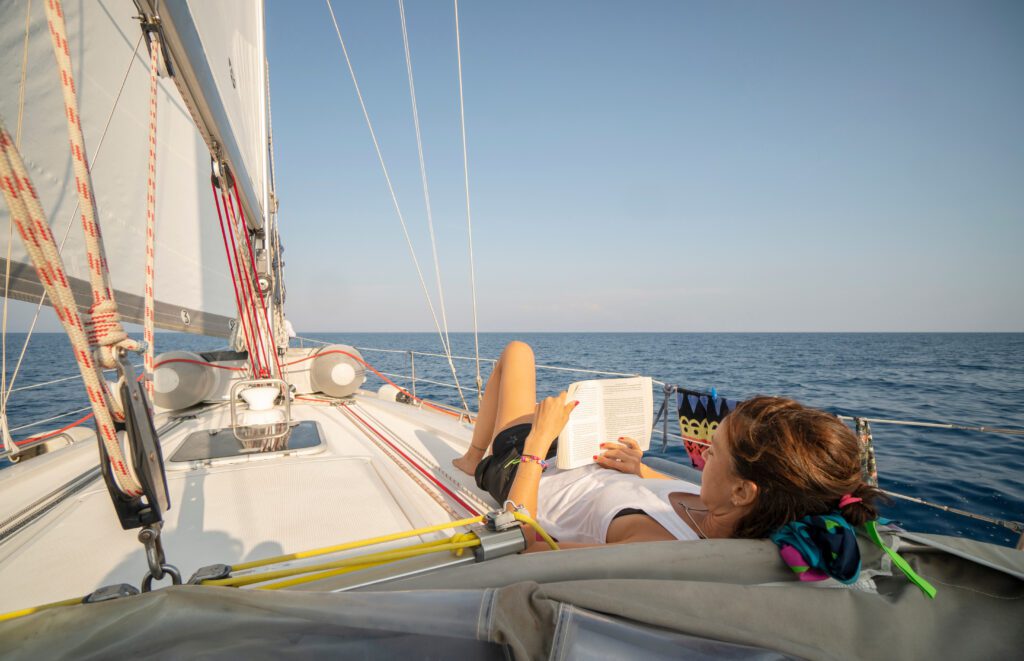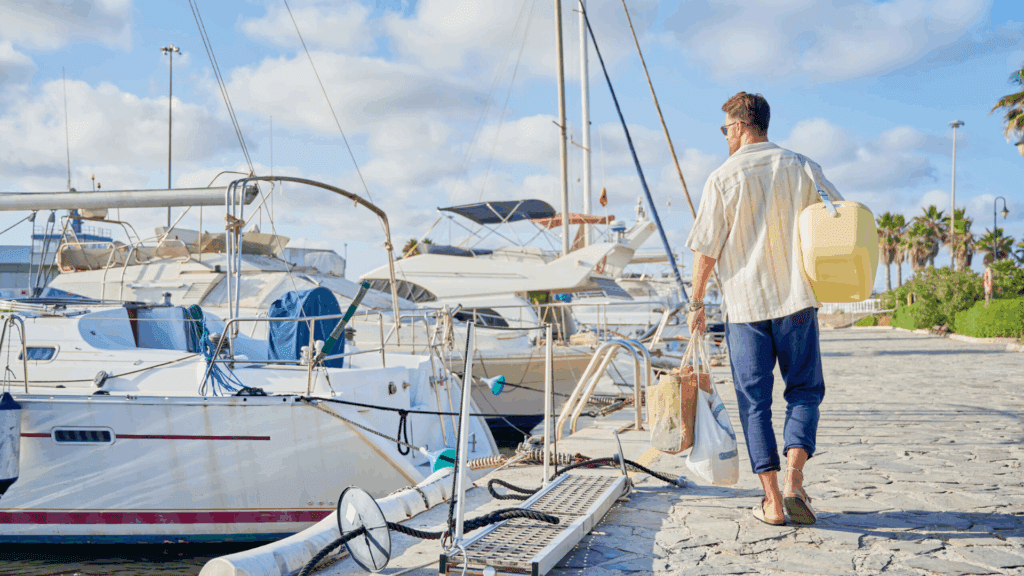Publication date: 06/16/2025 – Updated 09/12/2025
As a boater, when you set off on a cruise, you leave the familiar world ashore for an adventure that changes your perspective. Whether you’re navigating inland waterways, coastal areas, or open sea, you’re seeking a timeless experience that beckons you to slow down and see things anew. This is precisely what boaters from Port Adhoc marinas enjoy, especially with complimentary overnight stays included in their membership benefits.
But whether you’re aboard for a few days or a week, familiar waters or a brand-new area, how should you pack to ensure everything goes smoothly?
In this article, the Port Adhoc team invites you to follow 10 points to ensure you don’t miss a thing.
1. Choose a soft bag that stows easily on board
Space is at a premium on a boat. Leave your rigid suitcases ashore—they’re hard to store and unwieldy. Instead, choose a soft duffle or cruise bag which can be tucked away under a bunk, in a locker, or beneath a seat. Look for corrosion-resistant zips, water‑resistant fabric—or even fully waterproof models suitable for submersion.
We recommend leaving your rigid suitcases at home – they are not very useful once you are on board and are very difficult to store!
To avoid sacrificing storage space, opt for a soft cruise bag: it will be easier to handle on board. When empty, it can be stored in a locker, under a bunk or in a storage compartment.
💡Good to know: there are foldable models, with corrosion-resistant zips and water-repellent fabric. Some soft suitcases are also 100% waterproof, even in case of immersion.
2. Pack clothing suited to life at sea
Once you’ve chosen the ideal cruise bag, it’s time to fill it. Among the must-haves to include, as you can imagine, is marine clothing!
We recommend taking versatile and technical clothing – such as breathable T-shirts, a jacket, shorts and trousers… On a sailing boat in particular, along with sailing gloves, these will allow you to comfortably take part in manoeuvres.
If possible, choose garments made from lightweight fabrics: they’ll take up little space when folded and stored in the boat’s compartments, and they dry quickly.
On any body of water, the weather can change quickly: we advise planning ahead by bringing waterproof clothing (foul weather jacket, salopettes and/or sailing trousers) and a windbreaker.

In addition to navigation-specific clothing, pack underwear and comfortable clothes you can move around in easily: jogging bottoms or leggings, dresses, shorts or cropped trousers… And of course, don’t forget your swimsuit.
Evenings on board can be cool, even in southern Europe in summer: in a cruise bag, a fleece jacket is never too much!
Think about the space available on board, and avoid bringing more clothes than necessary: you can always do laundry by hand or using a machine on board or in the dedicated facilities in our network’s marinas.
Lastly, since we’re talking about laundry, don’t forget bedding, towels, as well as microfibre towels or a sarong for the beach…
3. Think about sun protection
On a lake, at sea or on a river, it’s not uncommon to get sunburnt while sailing: the sun’s reflection off the water and the boat deck can be devastating for the skin, while the wind often masks the sensation of exposure.
Depending on the type of boat you’re sailing on, your cruising area and the season, here’s a list of items that can help protect against UV rays:
- Lightweight but long clothing: long-sleeved T-shirts, trousers…
- Sunglasses with a strap, preferably floating
- A cap, bucket hat or sailing hat with a strap
- A Lycra top, or even top and bottom, for swimming and dinghy trips
- Waterproof sunscreen with sufficient protection – SPF 30, SPF 50 or SPF 50+, possibly suitable for children
- Lip balm with sun protection
- After-sun lotion to hydrate your skin at the end of the day
4. Prepare for stopovers
On a motorboat or sailing boat, it’s highly likely you’ll take part in one or more activities during your cruise.
Depending on the space available on your boat, you can bring equipment for water sports: water skiing, kayaking, stand-up paddleboarding, snorkelling, diving…
For onshore stopovers, bring reusable water bottles and hiking gear… or simply a dressier outfit to enjoy lovely evenings. A waterproof backpack will allow you to carry your personal belongings ashore securely. If you’re not familiar with your destination, a travel guide might also be a good idea!

5. Bring several pairs of shoes
For life on board, water activities or onshore excursions, remember to bring various pairs and types of shoes:
- For the boat, we recommend non-slip shoes, closed enough to protect your toes, and with white soles – so as not to mark the deck. Lightweight, these shoes dry quickly and will keep you comfortable in all situations.
- For beaches and anchorages, depending on your cruising area, flip-flops and water shoes can also be useful. The former will let you enjoy the sand and easily rinse your feet, while the latter will help you avoid injury on rocks or from sea urchins.
- For getting around on land, choose shoes suited to your activities: sandals for strolling, sturdy trainers for walking, hiking boots…
6. Put together a complete and personalised first-aid kit
To make the most of your stay, also pack medicines and equipment to help in case of emergency or medical need. The longer and further you plan to sail, the more comprehensive your first-aid kit should be.
For a coastal cruise of just a few days, in addition to your compulsory first-aid kit, you can bring over-the-counter basics you usually keep at home:
Items to disinfect, protect or close a wound (plasters or adhesive sutures), treat an allergy, soothe a headache or stomach ache, prevent seasickness (anti-nausea tablets, bracelets, goggles, patches)… If cruising in an area where necessary, also consider insect repellent and soothing cream.
If a crew member is following specific treatment, pack enough of their medication, along with prescriptions.
Check each medicine’s presence and expiry date before departure, and store everything in a waterproof, moisture-resistant pouch, out of children’s reach. In case of emergency, this kit must be easy and quick to access.
7. Toiletries, with respect for the environment
On a cruise, you’ll need the same toiletries as at home or for a weekend away. We recommend choosing environmentally friendly options!
Hanging toiletry bags are very handy in the small boat bathrooms. Inside, you can store solid or travel-sized toiletries – shampoo, soap, toothpaste… – and a flannel or washcloth to cleanse without using too much water.
8. Pack a few essentials for community life
On a cruise, depending on the crew composition, you’ll often take care of yourself or enjoy activities together. Some moments are great for socialising, others for solo pursuits:
- To enjoy shared moments with family or friends, bring along, for example, card or board games.
- Alone, you might want to read or draw, fish from the boat with some gear, or listen to music – ideally with earphones to avoid disturbing others.
Finally, at night, bring earplugs to block out ambient noise!

9. Choose your electronic devices carefully
Digital camera – possibly waterproof, tablet, e-reader, Bluetooth speaker… the electronics you pack will depend on you and your preferences. To charge them, don’t forget your usual cables and chargers.
On board, to recharge, you might use a USB cigarette-lighter adapter, a 12v → 220v converter, portable batteries, or a solar charger…
For night sailing, dinghy trips or searching deep in lockers, a rechargeable head torch will also come in handy.
10. Don’t forget the essential documents
Finally, before closing your cruise suitcase, don’t forget your documents:
- Your identity card and a copy of it
- Your boating licence (if required)
- The boat’s documents and your leisure boating insurance certificate
- Your means of payment (bank card, cash…)
If you plan to change countries during your cruise, you will take your passport and inform your bank of your upcoming destination. Medically, you will take your European Health Insurance Card (EHIC) and you may also choose to take out travel insurance as a complement.
Packing your cruise suitcase: the Port Adhoc checklist
Are you about to set off on a sailing trip lasting several days and need to pack your belongings? We suggest the following list of equipment – always choose items based on your needs and plans. 👇
Travel checklist — Boarding & onboard
Tick as you go to prepare your belongings.
Luggage
Clothing & linen
Sun protection
Documents
With effective packing preparation for your upcoming cruise, you will give yourself every chance to make the most of every moment.
Still unsure about how to plan ahead for your sailing trip or which equipment to bring on board? Just remember: in all Port Adhoc network marinas, our harbour staff are also there to help you!

